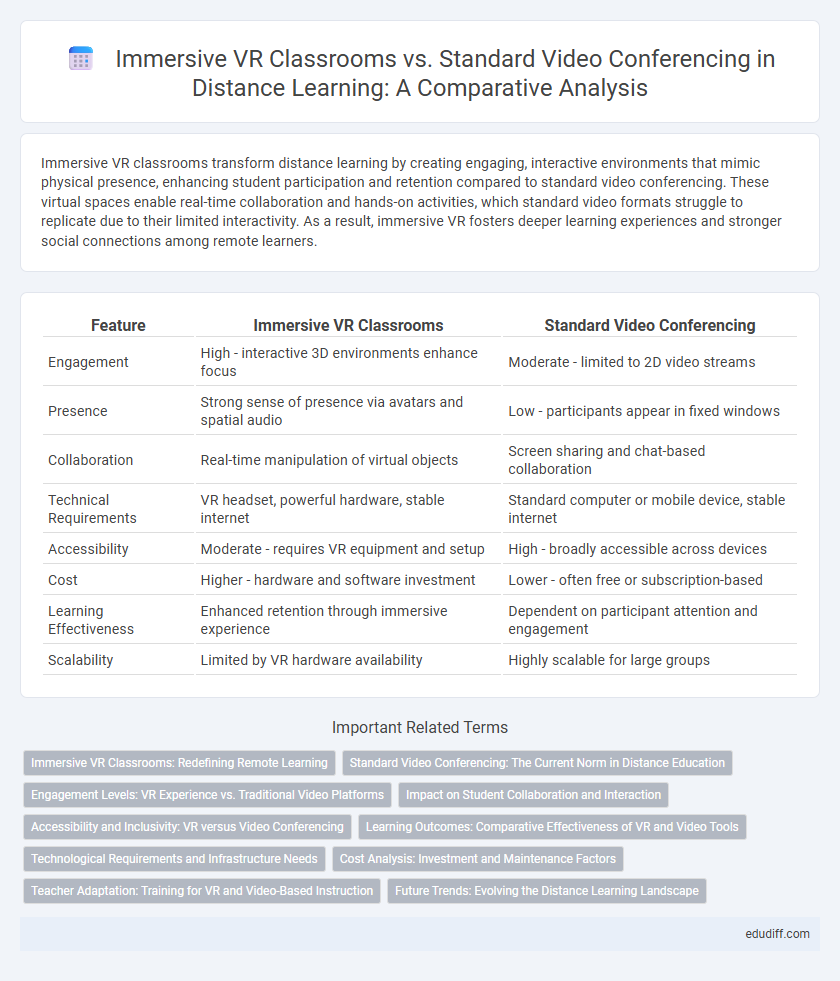Immersive VR classrooms transform distance learning by creating engaging, interactive environments that mimic physical presence, enhancing student participation and retention compared to standard video conferencing. These virtual spaces enable real-time collaboration and hands-on activities, which standard video formats struggle to replicate due to their limited interactivity. As a result, immersive VR fosters deeper learning experiences and stronger social connections among remote learners.
Table of Comparison
| Feature | Immersive VR Classrooms | Standard Video Conferencing |
|---|---|---|
| Engagement | High - interactive 3D environments enhance focus | Moderate - limited to 2D video streams |
| Presence | Strong sense of presence via avatars and spatial audio | Low - participants appear in fixed windows |
| Collaboration | Real-time manipulation of virtual objects | Screen sharing and chat-based collaboration |
| Technical Requirements | VR headset, powerful hardware, stable internet | Standard computer or mobile device, stable internet |
| Accessibility | Moderate - requires VR equipment and setup | High - broadly accessible across devices |
| Cost | Higher - hardware and software investment | Lower - often free or subscription-based |
| Learning Effectiveness | Enhanced retention through immersive experience | Dependent on participant attention and engagement |
| Scalability | Limited by VR hardware availability | Highly scalable for large groups |
Immersive VR Classrooms: Redefining Remote Learning
Immersive VR classrooms transform distance education by creating engaging, interactive 3D environments that mimic real-world learning spaces, significantly enhancing student presence and participation compared to standard video conferencing. These VR platforms leverage spatial audio, avatar interactions, and real-time collaboration tools to boost cognitive retention and reduce virtual fatigue. Many universities and corporate training programs report increased learner satisfaction and knowledge assimilation rates with immersive VR, positioning it as a powerful alternative to traditional remote learning methods.
Standard Video Conferencing: The Current Norm in Distance Education
Standard video conferencing remains the predominant tool in distance education, facilitating real-time interaction between instructors and students through platforms like Zoom and Microsoft Teams. Its widespread adoption is driven by accessibility, ease of use, and integration with existing educational technologies, enabling synchronous lectures, discussions, and collaborative activities. Despite limited immersion, video conferencing supports scalable and flexible learning environments essential for remote education continuity.
Engagement Levels: VR Experience vs. Traditional Video Platforms
Immersive VR classrooms significantly enhance engagement levels by providing interactive, 3D environments that mimic physical presence, fostering active participation and spatial awareness. Standard video conferencing platforms often limit user interaction to passive viewing and verbal communication, resulting in reduced attention and collaboration. Studies show VR learners retain information better and exhibit higher motivation compared to traditional video-based distance learning.
Impact on Student Collaboration and Interaction
Immersive VR classrooms significantly enhance student collaboration and interaction by providing a shared, 3D virtual environment where participants can engage in real-time spatial communication and hands-on activities, fostering deeper connection and teamwork. Standard video conferencing platforms primarily rely on 2D video and audio streams, which limit nonverbal cues, reduce spontaneity, and hinder dynamic group interactions. Research indicates that immersive VR leads to higher student engagement, increased participation rates, and improved collaborative problem-solving compared to traditional video conferencing methods.
Accessibility and Inclusivity: VR versus Video Conferencing
Immersive VR classrooms enhance accessibility by simulating real-world environments, allowing users with physical disabilities to fully participate without spatial constraints, unlike standard video conferencing which relies heavily on screen-based interaction that may limit engagement for some users. VR platforms offer customizable avatars and adaptive interfaces that support diverse learning needs, fostering greater inclusivity compared to conventional video conferencing tools. These features create more equitable educational experiences, bridging gaps caused by varying geographic locations and technological disparities.
Learning Outcomes: Comparative Effectiveness of VR and Video Tools
Immersive VR classrooms enhance learning outcomes by providing interactive, experiential environments that improve knowledge retention and engagement compared to standard video conferencing tools. Studies show VR learners demonstrate up to 30% better comprehension and application of complex concepts due to spatial awareness and active participation. Video conferencing lacks the immersive sensory feedback, often resulting in lower cognitive involvement and diminished collaborative problem-solving skills.
Technological Requirements and Infrastructure Needs
Immersive VR classrooms demand high-performance VR headsets, motion sensors, and robust GPUs to enable seamless 3D interaction, surpassing the standard video conferencing need for only webcams and microphones with basic computing power. The infrastructure for VR setups requires low-latency, high-bandwidth internet connections such as fiber-optic networks to prevent motion sickness and ensure real-time responsiveness. In contrast, standard video conferencing operates effectively on widespread broadband with minimal hardware, making it more accessible but less immersive.
Cost Analysis: Investment and Maintenance Factors
Immersive VR classrooms require higher initial investment in specialized hardware, software, and infrastructure compared to standard video conferencing solutions. Maintenance costs for VR setups include regular updates, technical support, and equipment repairs, which can exceed the relatively low upkeep expenses of conventional video conferencing platforms. Long-term cost efficiency depends on institutional scale and frequency of use, with immersive VR offering enhanced engagement but demanding greater financial commitment.
Teacher Adaptation: Training for VR and Video-Based Instruction
Teacher adaptation in immersive VR classrooms requires comprehensive training in virtual environment navigation, spatial interaction, and technical troubleshooting to ensure effective instruction delivery. In contrast, training for standard video-based instruction emphasizes mastering camera usage, audio clarity, and managing classroom engagement through screen-sharing tools. Effective preparation in both modalities enhances educators' ability to maintain student attention and foster interactive learning despite physical distance.
Future Trends: Evolving the Distance Learning Landscape
Immersive VR classrooms are poised to redefine distance learning by offering highly interactive and engaging environments that simulate physical presence, enhancing student participation and retention rates compared to standard video conferencing. Advanced technologies such as haptic feedback, spatial audio, and AI-driven personalization are driving the evolution of VR platforms, enabling more adaptive and immersive educational experiences. The integration of these innovations is expected to foster deeper cognitive engagement and collaboration, setting a new standard for remote education effectiveness and accessibility.
Immersive VR classrooms vs Standard video conferencing Infographic

 edudiff.com
edudiff.com